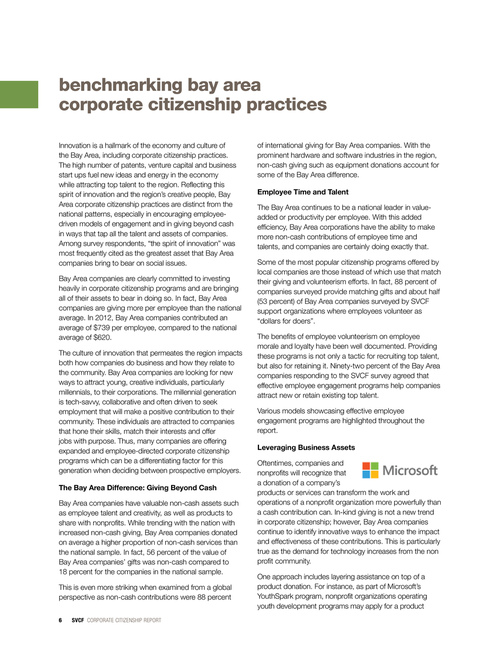
benchmarking bay area corporate citizenship practices
Innovation is a hallmark of the economy and culture of the Bay Area, including corporate citizenship practices. The high number of patents, venture capital and business start ups fuel new ideas and energy in the economy while attracting top talent to the region. Reflecting this spirit of innovation and the region’s creative people, Bay Area corporate citizenship practices are distinct from the national patterns, especially in encouraging employeedriven models of engagement and in giving beyond cash in ways that tap all the talent and assets of companies. Among survey respondents, “the spirit of innovation” was most frequently cited as the greatest asset that Bay Area companies bring to bear on social issues. Bay Area companies are clearly committed to investing heavily in corporate citizenship programs and are bringing all of their assets to bear in doing so. In fact, Bay Area companies are giving more per employee than the national average. In 2012, Bay Area companies contributed an average of $739 per employee, compared to the national average of $620. The culture of innovation that permeates the region impacts both how companies do business and how they relate to the community. Bay Area companies are looking for new ways to attract young, creative individuals, particularly millennials, to their corporations. The millennial generation is tech-savvy, collaborative and often driven to seek employment that will make a positive contribution to their community. These individuals are attracted to companies that hone their skills, match their interests and offer jobs with purpose. Thus, many companies are offering expanded and employee-directed corporate citizenship programs which can be a differentiating factor for this generation when deciding between prospective employers. The Bay Area Difference: Giving Beyond Cash Bay Area companies have valuable non-cash assets such as employee talent and creativity, as well as products to share with nonprofits. While trending with the nation with increased non-cash giving, Bay Area companies donated on average a higher proportion of non-cash services than the national sample. In fact, 56 percent of the value of Bay Area companies’ gifts was non-cash compared to 18 percent for the companies in the national sample. This is even more striking when examined from a global perspective as non-cash contributions were 88 percent
6 SVCF CORPORATE CITIZENSHIP REPORT
“Some of the most popular citizenship programs offered by local companies are those which match their giving and volunteerism efforts.”
of international giving for Bay Area companies. With the prominent hardware and software industries in the region, non-cash giving such as equipment donations account for some of the Bay Area difference. Employee Time and Talent The Bay Area continues to be a national leader in valueadded or productivity per employee. With this added efficiency, Bay Area corporations have the ability to make more non-cash contributions of employee time and talents, and companies are certainly doing exactly that. Some of the most popular citizenship programs offered by local companies are those instead of which use that match their giving and volunteerism efforts. In fact, 88 percent of companies surveyed provide matching gifts and about half (53 percent) of Bay Area companies surveyed by SVCF support organizations where employees volunteer as “dollars for doers”. The benefits of employee volunteerism on employee morale and loyalty have been well documented. Providing these programs is not only a tactic for recruiting top talent, but also for retaining it. Ninety-two percent of the Bay Area companies responding to the SVCF survey agreed that effective employee engagement programs help companies attract new or retain existing top talent. Various models showcasing effective employee engagement programs are highlighted throughout the report. Leveraging Business Assets Oftentimes, companies and nonprofits will recognize that a donation of a company’s products or services can transform the work and operations of a nonprofit organization more powerfully than a cash contribution can. In-kind giving is not a new trend in corporate citizenship; however, Bay Area companies continue to identify innovative ways to enhance the impact and effectiveness of these contributions. This is particularly true as the demand for technology increases from the non profit community. One approach includes layering assistance on top of a product donation. For instance, as part of Microsoft’s YouthSpark program, nonprofit organizations operating youth development programs may apply for a product
Median Total Giving per Employee
$
739
620
per employee Bay Area average
$
per employee national average
Greatest Asset of Bay Area Companies
SVCF CORPORATE CITIZENSHIP REPORT